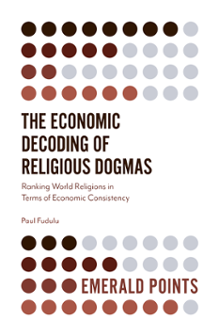
Prelims
The Economic Decoding of Religious Dogmas
ISBN: 978-1-78714-536-8, eISBN: 978-1-78714-535-1
Publication date: 2 June 2017
Citation
Fudulu, P. (2017), "Prelims", The Economic Decoding of Religious Dogmas, Emerald Publishing Limited, Leeds, pp. i-xii. https://doi.org/10.1108/978-1-78714-535-120171008
Publisher
:Emerald Publishing Limited
Copyright © 2017 Emerald Publishing Limited
Half Title Page
THE ECONOMIC DECODING OF RELIGIOUS DOGMAS
Ranking World Religions in Terms of Economic Consistency
Title Page
THE ECONOMIC DECODING OF RELIGIOUS DOGMAS
Ranking World Religions in Terms of Economic Consistency
BY
PAUL FUDULU
University of Bucharest, Bucharest, Romania

United Kingdom – North America – Japan – India – Malaysia – China
Copyright Page
Emerald Publishing Limited
Howard House, Wagon Lane, Bingley BD16 1WA, UK
First edition 2017
Copyright © 2017 Emerald Publishing Limited
Reprints and permissions service
Contact: permissions@emeraldinsight.com
No part of this book may be reproduced, stored in a retrieval system, transmitted in any form or by any means electronic, mechanical, photocopying, recording or otherwise without either the prior written permission of the publisher or a licence permitting restricted copying issued in the UK by The Copyright Licensing Agency and in the USA by The Copyright Clearance Center. Any opinions expressed in the chapters are those of the authors. Whilst Emerald makes every effort to ensure the quality and accuracy of its content, Emerald makes no representation implied or otherwise, as to the chapters’ suitability and application and disclaims any warranties, express or implied, to their use.
British Library Cataloguing in Publication Data
A catalogue record for this book is available from the British Library
ISBN: 978-1-78714-536-8 (Print)
ISBN: 978-1-78714-535-1 (Online)
ISBN: 978-1-78714-966-3 (Epub)


List of Figures
| Chapter 1 | ||
| Figure 1. | The Logic of the General Power Model Relative to the Influence of Religion on Economic Performance. | 19 |
| Figure 2. | The Logic of the Weberian Model Relative to the Influence of Religion on Economic Performance. | 20 |
| Figure 3. | The Logic of the General Power Model for Analyzing the Economic Consistency of Religions Starting from Religious Rules and Institutions. | 22 |
| Figure 4. | The Logic of the General Power Model for Analyzing the Economic Consistency of Religions Starting from Religious Values. | 23 |
| Chapter 3 | ||
| Figure 5. | The Level of Asceticism and Hedonism of the Great Religions. | 66 |
| Figure 6. | The Economic Consistency Ranking of Religions Based on the Criterion of the Level of Transcendence. | 80 |
| Figure 7. | The Economic Consistency Ranking of Religions According to the Criterion of the Importance of Afterlife. | 98 |
| Chapter 4 | ||
| Figure 8. | The Economic Consistency Rankings of the Great Religions for Each Criterion and Overall. | 146 |
| Figure 9. | The Evolution of the Economic Consistency of Judaism. | 149 |
| Figure 10. | The Evolution of the Economic Consistency of Christianity. | 150 |
| Figure 11. | The Evolution of the Economic Consistency of Islam. | 151 |
| Figure 12. | The Evolution of the Economic Consistency of Buddhism. | 152 |
Foreword
The economic theory of religion is a relatively new scientific field. However, this research project was not born out of my desire to pursue a new and very interesting research direction. The fact that the research communicated through this book has been performed at the beginning of this new scientific endeavor is simply coincidence. The study of the influence of religious values and institutions on economic performance has been a natural stage in my long-term, nonorthodox, personal research program. Hence, it should be no surprise that the methodology and conclusions derived from this research are quite different from others’.
The analytical model I propose in this book is based on my previous studies regarding the formation of preferences and cultural values as well as the nature of rules and institutions. All studies were performed within a fundamentally different paradigm. This book is the first major test of the general power paradigm — a paradigm for which I have struggled to attain recognition. The results are beyond my expectations. Through using an analytical model quite different from that of standard economic theory, rational choice perspective and the Weberian model, I proved something that, from the perspective of orthodox social science inspired by Western culture, is hardly imaginable. Specifically, religious values, rules, and institutions intrinsically contain direct and indirect rankings of the mega-objective absolute wealth (or economic performance) and, as such, they predetermine the economic performance of communities that embrace those religions.
Because the level of economic performance determined by a religion is encoded in its dogma, nothing else but religious dogma should be studied or decoded by economists. Just the outside, plain aspects of religious activities — like religiosity — cannot but mislead. It is equally misleading to study the correlation between dominant religions and economic performance of the corresponding communities. This is so because the economic performance of many countries has increasingly depended on economic systems and institutions they have been forced or induced to adopt and which have nothing in common with their own cultures and, as such, their own religions.
The standard economic models for analyzing religion are not fit to tackle this problem. It seems it is impossible to economically decode religious dogmas and derive a solid economic consistency ranking of religions other than from the perspective taken in this book, and by its derivative concepts and correlations.